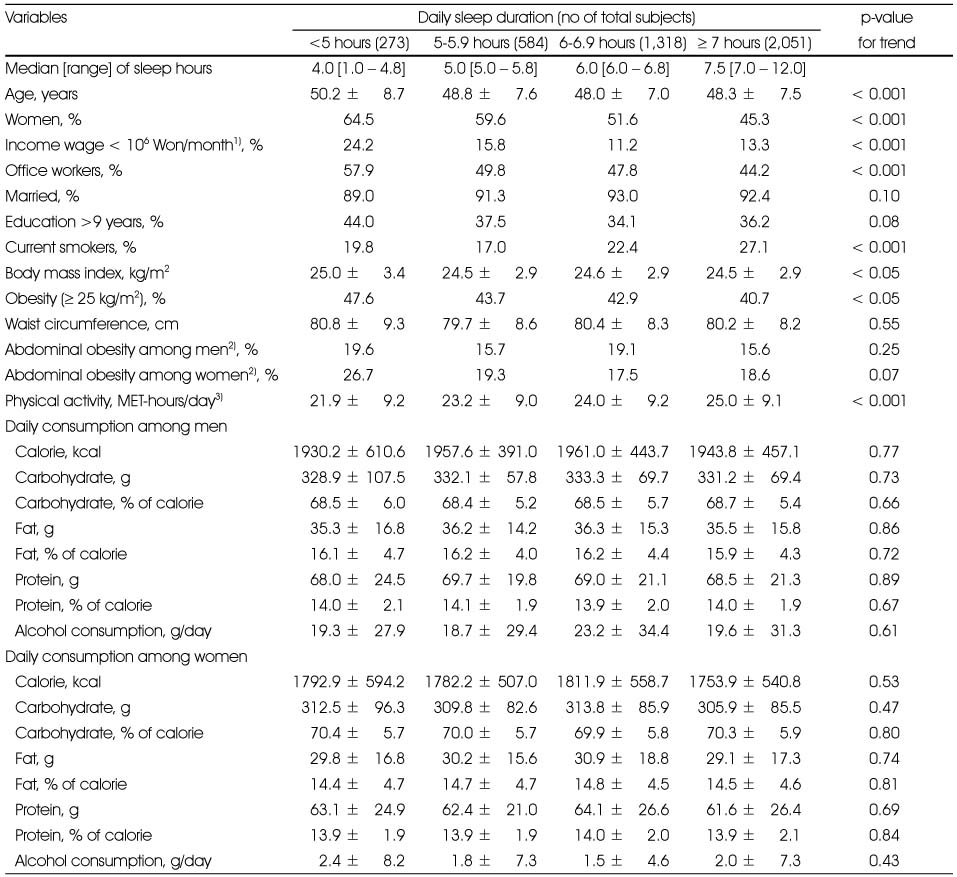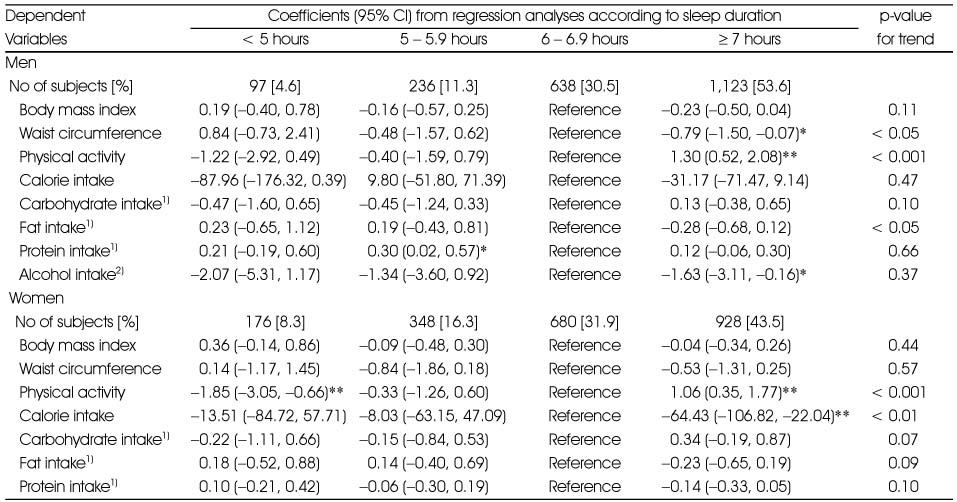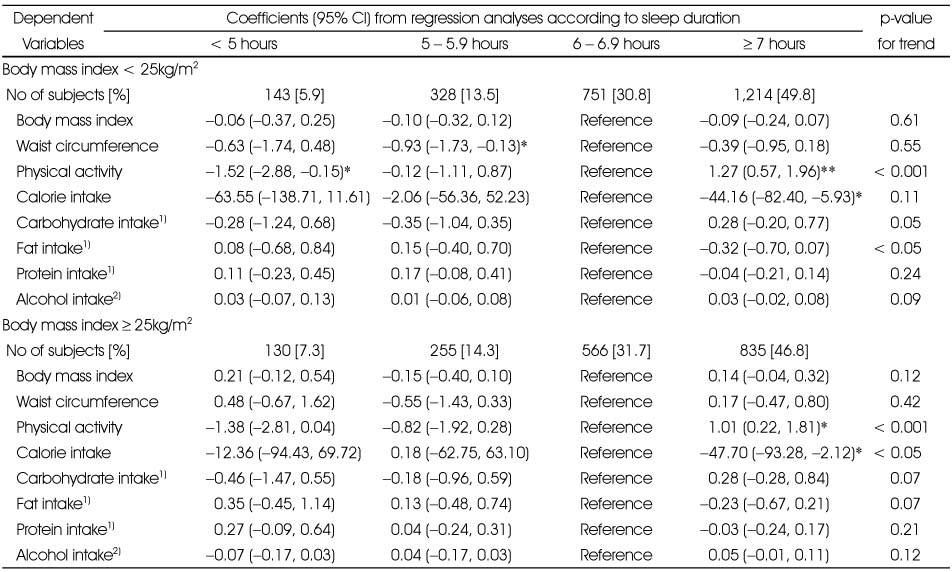Articles
- Page Path
- HOME > Korean J Community Nutr > Volume 16(3); 2011 > Article
-
Original Article
- Association of Daily Sleep Duration with Obesity, Macronutrient Intake, and Physical Activity
- Inkyung Baik, Chol Shin
-
Korean Journal of Community Nutrition 2011;16(3):315-323.
DOI: https://doi.org/10.5720/kjcn.2011.16.3.315
Published online: June 30, 2011
Department of Foods and Nutrition, College of Natural Sciences, Kookmin University, Seoul, Korea.
1Department of Internal Medicine, Korea University Ansan Hospital, Ansan, Korea.
- Corresponding author: Chol Shin, Division of Pulmonary and Critical Care Medicine, Department of Internal Medicine Korea University Ansan Hospital, 516 Gojandong, Danwongu, Ansan, Gyeonggido 425-707, Korea. Tel: (031) 412-5606, Fax: (031) 412-5604, chol-shin@korea.ac.kr
Copyright © 2011 The Korean Society of Community Nutrition
- 1,275 Views
- 0 Download
- 13 Crossref
Figure & Data
REFERENCES
Citations

- Analysis of Anti-Stress and Sleep-Inducing Effects of a Zizyphus jujuba Mill.-Hypericum perforatum L. Mixture and Its Bioactive Compounds
June-Seok Lim, Yeon-Seok Seong, Geon Oh, Ji-Hyun Im, Xiaolu Fu, Min-Hye Kim, Jin-Ho Roh, Ok-Hwan Lee
Journal of the Korean Society of Food Science and Nutrition.2025; 54(6): 489. CrossRef - A comparative study on eating habits and mental health of Korean middle school students according to their bedtime across regions: using data from the 2020–2022 Korea Youth Risk Behavior Survey
Sarim Kim, Jiyoung Jeong, Juyeon Kang, Jihye Kim, Yoon Jung Yang
Nutrition Research and Practice.2024; 18(2): 269. CrossRef - Grit in Community‐Dwelling Older Adults with Low Back Pain Is Related to Self‐Physical Training Habits
Tsubasa Kawasaki, Ryosuke Tozawa
PM&R.2020; 12(10): 984. CrossRef - Health Behaviors and Dietary Habits according to Sleep Duration in Korean Adults Based on the 2013–2015 Korea National Health and Nutrition Examination Survey
Jin-A Kim, Sim-Yeol Lee
Korean Journal of Health Promotion.2019; 19(4): 237. CrossRef - The longitudinal influence of child maltreatment on child obesity in South Korea: The mediating effects of low self-esteem and depressive symptoms
Aely Park, Youngmi Kim
Children and Youth Services Review.2018; 87: 34. CrossRef - Dietary behavior status and its association with study-related factors in middle school students in Gyeonggi area
Myoung Sook Lee, Wha Jin Hyun, Kyung Hee Song
Journal of Nutrition and Health.2018; 51(5): 455. CrossRef - Relationship between Bone Mineral Density and Bone Metabolic Biochemical Markers and Diet Quality Index-International(DQI-I) in Postmenopausal Obese Women
Yeonah Jeong, Misung Kim, Saeron Shin, Ahreum Han, Geomsuk Seo, Cheongmin Sohn
Korean Journal of Community Nutrition.2016; 21(3): 284. CrossRef - Difference in Sleep Circadian Rhythm and Sleep Quality between Normal-weight and Obese Group
Hyun Jin Suk, Yeon Kyung Na, Hae Sook Hong
Journal of Korean Biological Nursing Science.2014; 16(4): 309. CrossRef - Experiences of Health Related Lifestyles in High Body Fat but Non-obese Female College Students in Korea
Jeongsoo Kim
Osong Public Health and Research Perspectives.2014; 5(1): 68. CrossRef - Predictors of Poor Sleep Quality among Nursing Students
Young Ran Chae, Dong Hee Choi, Su Jeong Yu
Journal of Korean Biological Nursing Science.2014; 16(2): 98. CrossRef - Correlation between Sleep Quality and Snack Intake in Third Year Middle and High School Students in the Gwangju Area
Hyo Bok Kim, Yang Won Park
Journal of the Korean Society of Food Science and Nutrition.2013; 42(2): 212. CrossRef - A Study on the Correlation of the accompanying symptoms, Heart Rate Variability and Body Component Analysis in 350 Insomnia Patients
Ji-Won Ha, Bo-Kyung Kim, Jin-Hyeong Jung
Journal of Oriental Neuropsychiatry.2012; 23(3): 47. CrossRef - Physical activity level, total daily energy expenditure, and estimated energy expenditure in normal weight and overweight or obese children and adolescents
Myung Hee Kim, Eun Kyung Kim
Korean Journal of Nutrition.2012; 45(6): 511. CrossRef
Baseline characteristics across categories of daily sleep duration among 4,226 persons
1) Approximately corresponding to the government-set-minimum wage for a family of three persons
2) Abdominal obesity is defined as having waist circumference of 90cm or greater for men and of 85cm or greater for women
3) Average daily metabolic equivalents-hours
Association of daily sleep duration with obesity, physical activity, and intake
Abbreviation: CI, confidence interval, *: p-value < 0.05; **: p-value < 0.01
In a multivariate model, data are adjusted for age, sex, body mass index, income (wage < 106 Won/month, 106 + Won/month), occupation (office workers or non-office workers and housework), marital status (married, other status), education (< 9 years, 9+ years), smoking status (non-smoker, current smoker; ≤ 10, 10 - 20, and >20 cigarettes/day), alcohol intake (lifetime abstainers, current abstainers, curent alcohol consumption; < 5.1 g, 5.1 - 15, 15.1 - 30, > 30 g/day), quintiles of physical activity (MET-hours/day), and quintiles of calorie intake; however, body mass index is not included as a covariate for waist circumference and calorie intake is not included for macronutrient intake.
1) percent of calorie, 2) grams per day
Association of daily sleep duration with obesity, physical activity, and intake by sex
Abbreviation: CI, confidence interval, *: p-value < 0.05; **: p-value < 0.01
In a multivariate model, data are adjusted for age, sex, body mass index, income (wage < 106 Won/month, 106 + Won/month), occupation (office workers or non-office workers and housework), marital status (married, other status), education (< 9 years, 9+ years), smoking status (non-smoker, current smoker; ≤ 10, 10 - 20, and > 20 cigarettes/day), alcohol intake (lifetime abstainers, current abstainers, curent alcohol consumption; < 5.1 g, 5.1 - 15, 15.1 - 30, > 30 g/day), quintiles of physical activity (MET-hours/day), and quintiles of calorie intake; however, body mass index is not included as a covariate for waist circumference and calorie intake is not included for macronutrient intake.
1) percent of calorie, 2) grams per day
Association of daily sleep duration with obesity, physical activity, and intake by the categories of obesity
Abbreviation: CI, confidence interval, *: p-value < 0.05; **: p-value < 0.01
In a multivariate model, data are adjusted for age, sex, body mass index, income (wage < 106 Won/month, 106 + Won/month), occupation (office workers or non-office workers and housework), marital status (married, other status), education (< 9 years, 9+ years), smoking status (non-smoker, current smoker; ≤ 10, 10 - 20, and >20 cigarettes/day), alcohol intake (lifetime abstainers, current abstainers, curent alcohol consumption; < 5.1g, 5.1 - 15, 15.1 - 30, >30 g/day), quintiles of physical activity (MET-hours/day), and quintiles of calorie intake; however, body mass index is not included as a covariate for waist circumference and calorie intake is not included for macronutrient intake.
1) percent of calorie, 2) grams per day
Multivariate coefficients (95% CI) for obesity, physical activity, and intake in the association with daily sleep duration as an outcome
Abbreviation: CI, confidence interval, **: p-value < 0.001
In a multivariate model, daily sleep duration (minutes/day) is fitted as a continuous variable with covariates including age, sex, waist circumference, income (wage < 106 Won/month, 106 + Won/month), occupation (office workers or non-office workers and housework), marital status (married, other status), education (< 9 years, 9 + years), smoking status (non-smoker, current smoker; ≤ 10, 10 - 20, and >20 cigarettes/day), alcohol intake (g/day), physical activity (MET-hours/day), calorie intake (kcal/day), and consumption of carbohydrate, fat, and protein (percent of calorie intake)
1) Approximately corresponding to the government-set-minimum wage for a family of three persons 2) Abdominal obesity is defined as having waist circumference of 90cm or greater for men and of 85cm or greater for women 3) Average daily metabolic equivalents-hours
Abbreviation: CI, confidence interval, *: p-value < 0.05; **: p-value < 0.01 In a multivariate model, data are adjusted for age, sex, body mass index, income (wage < 106 Won/month, 106 + Won/month), occupation (office workers or non-office workers and housework), marital status (married, other status), education (< 9 years, 9+ years), smoking status (non-smoker, current smoker; ≤ 10, 10 - 20, and >20 cigarettes/day), alcohol intake (lifetime abstainers, current abstainers, curent alcohol consumption; < 5.1 g, 5.1 - 15, 15.1 - 30, > 30 g/day), quintiles of physical activity (MET-hours/day), and quintiles of calorie intake; however, body mass index is not included as a covariate for waist circumference and calorie intake is not included for macronutrient intake. 1) percent of calorie, 2) grams per day
Abbreviation: CI, confidence interval, *: p-value < 0.05; **: p-value < 0.01 In a multivariate model, data are adjusted for age, sex, body mass index, income (wage < 106 Won/month, 106 + Won/month), occupation (office workers or non-office workers and housework), marital status (married, other status), education (< 9 years, 9+ years), smoking status (non-smoker, current smoker; ≤ 10, 10 - 20, and > 20 cigarettes/day), alcohol intake (lifetime abstainers, current abstainers, curent alcohol consumption; < 5.1 g, 5.1 - 15, 15.1 - 30, > 30 g/day), quintiles of physical activity (MET-hours/day), and quintiles of calorie intake; however, body mass index is not included as a covariate for waist circumference and calorie intake is not included for macronutrient intake. 1) percent of calorie, 2) grams per day
Abbreviation: CI, confidence interval, *: p-value < 0.05; **: p-value < 0.01 In a multivariate model, data are adjusted for age, sex, body mass index, income (wage < 106 Won/month, 106 + Won/month), occupation (office workers or non-office workers and housework), marital status (married, other status), education (< 9 years, 9+ years), smoking status (non-smoker, current smoker; ≤ 10, 10 - 20, and >20 cigarettes/day), alcohol intake (lifetime abstainers, current abstainers, curent alcohol consumption; < 5.1g, 5.1 - 15, 15.1 - 30, >30 g/day), quintiles of physical activity (MET-hours/day), and quintiles of calorie intake; however, body mass index is not included as a covariate for waist circumference and calorie intake is not included for macronutrient intake. 1) percent of calorie, 2) grams per day
Abbreviation: CI, confidence interval, **: p-value < 0.001 In a multivariate model, daily sleep duration (minutes/day) is fitted as a continuous variable with covariates including age, sex, waist circumference, income (wage < 106 Won/month, 106 + Won/month), occupation (office workers or non-office workers and housework), marital status (married, other status), education (< 9 years, 9 + years), smoking status (non-smoker, current smoker; ≤ 10, 10 - 20, and >20 cigarettes/day), alcohol intake (g/day), physical activity (MET-hours/day), calorie intake (kcal/day), and consumption of carbohydrate, fat, and protein (percent of calorie intake)

 KSCN
KSCN





 Cite
Cite


